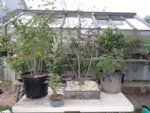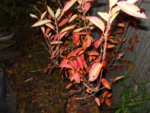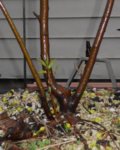@coh
I did post mine before but I could not find it. My study group, ''Arbor Arts Collective'', we did a group project, I bought 12 Amelanchier x Grandiflora, we all took one, I ended up with two, the one I picked and the one nobody wanted. This was Spring 2015. Click to expand small images.
Spring 2015

In May of 2016 a few of us (4 of us) remembered to bring our Service berries to a get together to compare notes. All trees on the table are the same cultivar of Amelanchier x grandiflora. The differences are because of how they were treated. The one on the left was pretty much as it came from the nursery. Note the one pruned drastically and plopped right into a bonsai training pot. Others were put into various grow out containers. Mine is the one in the Anderson flat where I did drastic root work but no pruning. Others did pruning but no root work. Some did it all. Pruning and root work all at once. I think the all at once are further in development. But the test will be the comparison summer of 2020.


Landscape tree in bloom at Irene's house, mine in bloom on the ground in front of Irene's tree.

flowers 2016

fruit


fall color

2016 one I left tall, and did the serious root work to get into 4 inches deep (10 cm) anderson flat, 17 x 17 x 5 inches (52 x 52 x 12.5 cm) I'm thinking I will reduce this to either a single trunk, or a 2 trunk clump. Not happy with the awkward crook in the largest diameter trunk.

Number 2 - I chopped short and to a single trunk right away, spring 2015, then spring 2016 moved to an anderson flat. What I had pruned, I stuck in the flat as cuttings. None of the cuttings took. I am keeping this one as a single trunk.

This year I need to clean up the scars on #2, and do some serious pruning on #1.
#1 bloomed and produced fruit every year, but I left it tall. #2 has not bloomed since I chopped it back. I'm hoping it will start blooming again. I suspect you have to stop pruning before the middle of July if you want flowers the following spring.
All in all, I have not paid these as much attention as I could have. I could have pushed them faster. But they are nice. Disease free so far. And very reminiscent of a crab apple, but with smaller leaves, earlier flowers.










